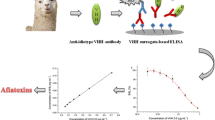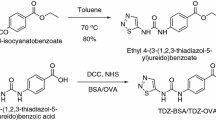Abstract
A direct competitive enzyme-linked immunosorbent assay (ELISA) based on a monoclonal antibody has been developed and optimized for detection of aflatoxin B1 (AFB1), and an ELISA kit has been designed. This immunoassay was highly specific, sensitive, rapid, simple, and suitable for aflatoxin monitoring. AFB1 concentrations determinable by ELISA ranged from 0.1 to 10 μg L−1. The IC50 value was 0.62 μg L−1. Recovery from spiked rice samples averaged between 94 and 113%. The effect of different reagents on the stability of HRP–AFB1 conjugate solution was studied. The performance of a stabilized enzyme tracer in ELISA was determined and compared with that of a freshly prepared control solution of HRP–AFB1 conjugate. The results showed that stabilizing media containing 0.02% BSA, 0.1% Kathon CG, and 0.05 mol L−1 calcium chloride in 0.05 mol L−1 Tris-HCl buffer (pH 7.2) maintained the activity of HRP–AFB1 at a dilution of 1:1000 for a period of at least 12 months at room temperature whereas the reference conjugate solution without the additives lost its activity within a few days. Several additives were tested for their stabilizing effect on a monoclonal antibody (MAb) immobilized on the surface of polystyrene microtitre plates. It was shown that immobilized MAb, treated with post-coating solutions containing PVA, BSA, and combinations of these substances with trehalose, retained its activity for at least 4 months at 4°C, whereas the untreated MAb-coated plate lost its activity within 2 days.





Similar content being viewed by others
References
International Agency for Research on Cancer (1993) IARC monograph on the evaluation of carcinogenic risk to humans, vol 56. IARC, Lyon, France
Food and Agriculture Organisation of the United Nations (1995) FAO Food and Nutrition Paper. FAO, Rome, Italy
European Commission (1998), Commission Regulation 1525/98 Off J L201, 0093
Scott PM (1993) Trends Anal Chem 12(9):382–386
Stroka J, van Otterdijk R, Anklam E (2000) J Chromatogr A 904:251–256
Jaimez J, Fente CA, Vazquez BI, Franco CM, Cepeda A, Mahuzier G, Prognon P (2000) J Chromatogr A 882:1–10
Papp E, Otta KH, Záray G, Mincsovics E (2002) Microchem J 73:39–46
Otta KH, Papp E, Bagócsi B (2000) J Chromatogr A 882:11–16
Escobar A, Regueiro OS (2002) J Food Prot 65(1):219–221
Park JW, Kim EK, Kim YB (2004) Food Addit Contam 21(1):70–75
Lee NA, Wang S, Allan RD, Kennedy IR (2004) J Agric Food Chem 52:2746–2755
Roch OG, Blunden G, Coker RD, Nawaz S (1995) Food Chem 52:93–98
Holcomb M, Thompson HC Jr, Cooper WM, Hopper ML (1996) J Supercrit Fluids 9:118–121
Elizalde-González MP, Mattusch J, Wennrich R (1998) J Chromatogr A 828:439–444
Sharma M, Márquez C (2001) Animal Feed Sci Technol 93:109–114
Blesa J, Soriano JM, Moltó JC, Marín R, Maòes J (2003) J Chromatogr A 1011:49–54
Chiavaro E, Dall'Asta C, Galaverna G, Biancardi A, Gambarelli E, Dossena A, Marchelli R (2001) J Chromatogr A 937:31–40
Peòa R, Alcaraz MC, Arce L, Ríos A, Valcárcel M (2002) J Chromatogr A 967:303–314
Marrazza G, Chianella I, Mascini M (1999) Anal Chim Acta 387:297–307
Maragos CM, Thompson VS (1999) Nat Toxins 7:371–376
Van der Gaag B, Spath S, Dietrich H, Stigter E, Boonzaaijer G, van Osenbruggen T, Koopal K (2003) Food Control 14:251–254
Devi KT, Mayo MA, Reddy KLN, Delfosse P, Reddy G, Reddy SV, Reddy DVR (1999) Lett Appl Microbiol 29:284–288
Gathumbi JK, Usleber E, Märtlbauer E (2001) Lett Appl Microbiol 32:349–351
Korde A, Pandey U, Banerjee S, Sarma HD, Hajare S, Venkatesh M, Sharma AK, Pillai MRA (2003) J Agric Food Chem 51:843–846
Garden SR, Strachan NJC (2001) Anal Chim Acta 444:187–191
Daly SJ, Keating GJ, Dillon PP, Manning BM, O'Kennedy R, Lee HA, Morgam MRA (2000) J Agric Food Chem 48:5097–5104
Ho J-AA, Wauchope RD (2002) Anal Chem 74:1493–1496
Pal A, Dhar TK (2004) Anal Chem 76:98–104
Nasir MS, Jolley ME (2002) J Agric Food Chem 50:3116–3121
Bhattacharya D, Bhattacharya R, Dhar TK (1999) J Immunol Methods 230:71–86
Lipigorngoson S, Limtrakul P, Suttajit M, Yoshizawa T (2003) Food Addit Contam 20(9):838–845
Gathumbi JK, Usleber E, Ngatia TA, Kangethe EK, Märtlbauer E (2003) Poult Sci 82(4):585–590
Ó'Fágáin C (1995) Biochim Biophys Acta 1252:1–14
Ó'Fágáin C (2003) Enzyme Microb Technol 33:137–149
Schütz AJ, Winklmair M, Weller MG, Niessner R (1997) SPIE 3105:332–340
Kühlmeyer C, Klein J (2002) Enzyme Microb Technol 6196:1–8
Dankwardt A, Müller J, Hock B (1998) Anal Chim Acta 362:35–45
Eremin AN, Budnikova LP, Sviridov OV, Metelitsa DI (2002) Appl Biochem Microbiol 38(2):151–158
Chu FS, Hsia MTS, Sun PS (1977) J AOAC Int 60:791–794
Langone JJ, Van Vunakis H (1975) Res Commun Chem Pathol Pharmacol 10:163–171
Kolosova AYu, Park JH, Eremin SA, Kang SJ, Chung DH (2003) J Agric Food Chem 51:1107–1114
Heiss C, Weller MG, Niessner R (1999) Anal Chim Acta 396:309–316
Acknowledgements
This research was partially supported by the National Toxicology Program of the National Institute of Toxicological Research, Brain Korea 21 Program from the Ministry of Education and the Environmental Biotechnology National Core Research Centre (grant R15-2003-012-01001-0) from KOSEF/MOST, Korea.
Author information
Authors and Affiliations
Corresponding author
Rights and permissions
About this article
Cite this article
Kolosova, A.Y., Shim, WB., Yang, ZY. et al. Direct competitive ELISA based on a monoclonal antibody for detection of aflatoxin B1. Stabilization of ELISA kit components and application to grain samples. Anal Bioanal Chem 384, 286–294 (2006). https://doi.org/10.1007/s00216-005-0103-9
Received:
Revised:
Accepted:
Published:
Issue Date:
DOI: https://doi.org/10.1007/s00216-005-0103-9




